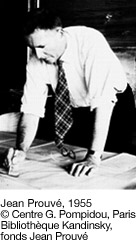
Jean Prouvé (1901–1984) was a twentieth-century pioneer in the innovative production of furniture and architecture.
Determined to be a man of his time, Prouvé explored all the current technical resources in metalworking, soon abandoning wrought iron for bent sheet steel: in the thirties he produced metal joinery, his early furniture, architectural components and knockdown buildings, all in small series.
Beginning with the construction of wrought-iron gateways, railings and windows, from 1924 onwards Jean Prouvé created his first items of furniture. Having discovered electric welding and the application of diverse techniques of construction, he resorted to sheet-steel (particularly used in the automobile industry) of an extreme thinness permitting him to obtain a “hollow-body” which allowed for a structure of exceptional resistance: the reclining chair of 1929 is a typical example. The use of this metal is found in most of the furniture that marked his development. Jean Prouvé frequently employed aluminium in the form of corrugated sheet metal and molded elements.
In 1945, Prouvé built his factory in Maxeville, where he stayed until 1954. Thereafter, he continued his activities as a consulting-engineer for large architectural projects. Of the opinion that "in their construction there is no difference between a piece of furniture and a house", he developed a "constructional philosophy" based on functionality and rational fabrication. Free of all artifice, the resultant aesthetic chimed with the doctrine of the Union of Modern Artists, of which Prouvé – with Le Corbusier, Pierre Jeanneret and Charlotte Perriand – was a founder member.
The same principles were applied to the making of furniture – often intended for the public sector – and to the architecture of the postwar boom. Astute assembly systems for hard-wearing structures meant that furniture and buildings alike could be readily dismantled, moved about and adapted.
Aside from educational furniture, Jean Prouvé furnished offices and created chairs, tables, shelves, bookshelves and cabinets, all following the same construction principles: based on a sketch, a prototype was realized in order for its details to be assessed through a very strict evaluation process.
From 1956 onwards, the gallery Steph Simon distributed his furniture. Jean Prouvé contributed considerably to the reconstruction and urbanization of France after the war. Always being a true entrepreneur, he was able to break away from traditional means of construction while giving priority to experience over profit.
The Prouvé blend of avant-garde spirit and humanist concerns has lost none of its relevance.
The originality of his different periods is repeatedly rediscovered, from the first items for the University dormitory in Nancy in 1932 through those for a similar facility in Antony in 1954; the furniture for Africa; and the knockdown postwar schools and "little architecture machines" of the sixties.
He filled numerous orders such as the University of Nancy in 1932 and the furniture for the cafeteria des Arts et Métiers, Cité Internationale Universitaire Paris in 1950. Working with the best architects, Jean Prouvé left his stamp on many famous examples of twentieth-century building, most of which are now classified historic monuments.